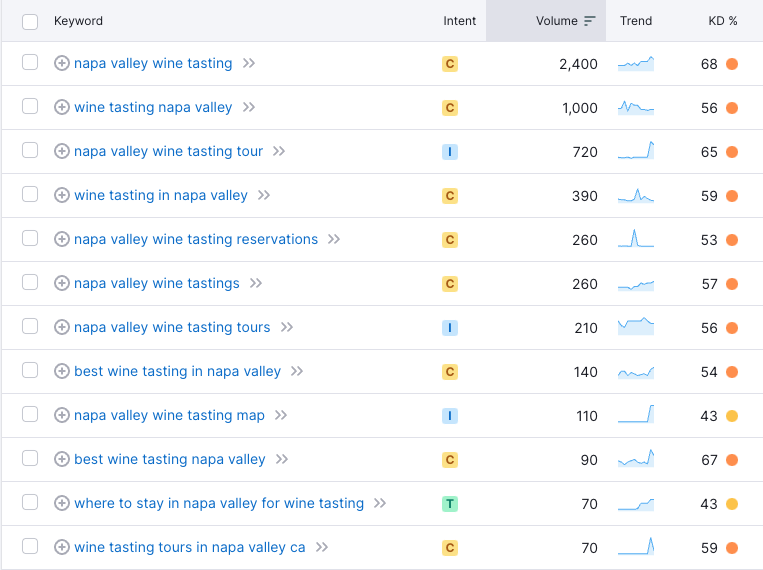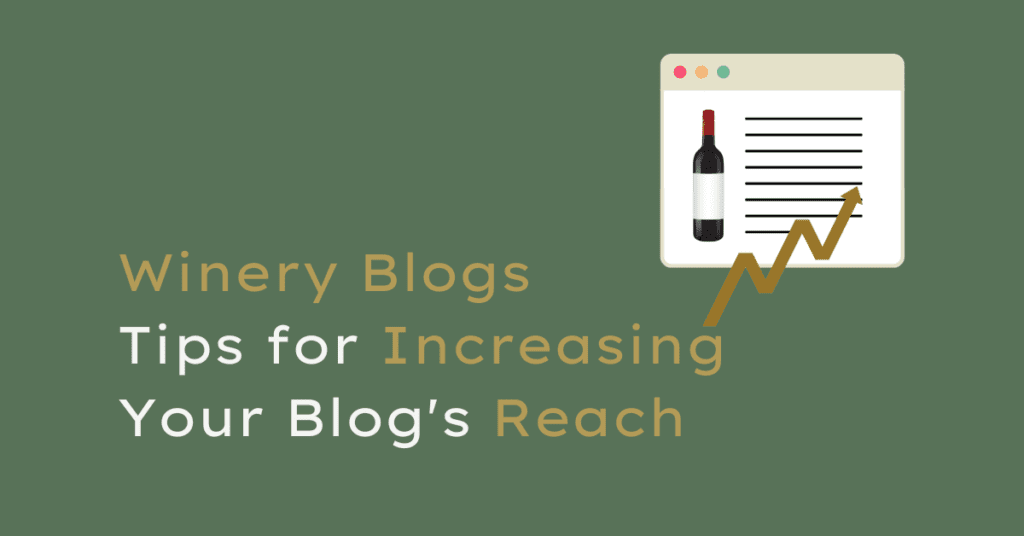Have you ever wondered why some winery blogs just seem to ‘pop’ in a Google search, while others languish unseen? The answer lies not in the quality of their Cabernet Sauvignon but within an invisible vineyard called SEO.
Much like tending to vines, optimizing your blog for search engines is no overnight job. But when done right, it can be as rewarding as uncorking that perfect bottle of wine after years of aging.
In this swirling glass full of insights and practical advice on SEO tips for winery blogs, we’ll take a journey through keyword selection’s fertile soil, explore the robust flavors added by effective content creation and learn how visuals enhance your post much like beautiful wine glasses amplify tasting experiences.
But don’t get overwhelmed by jargon. It’s more about relishing every bit of insight we can get.
The Power of Blogging for Wineries
It’s no mystery that blogging can be an invaluable asset for wineries. It gives you an opportunity to tell your story, share insights about the wine industry, and even boost website traffic through improved search engine rankings. But let’s delve deeper into why blogging is such a powerful tool for wineries.
Crafting Effective Blog Content for Your Winery
A well-crafted blog post does more than just entertain; it provides value to your readership—your potential customers. The trick lies in creating content that appeals not only to wine lovers but also helps improve search engine optimization (SEO).
Digital marketing has evolved over the years, with SEO taking center stage in driving organic traffic towards websites. So how do we integrate this aspect into our blogs? First off, make sure each blog post focuses on topics relevant to your target audience—the people who love what you do as much as you love doing it.
Then comes integrating keywords—a critical part of any successful SEO campaign—into these posts naturally and contextually without sounding forced or out of place. Keyword research tools are handy when identifying which terms your potential customers use while searching online for information related to wines or wineries.
- Create engaging narratives: Storytelling is crucial in connecting with readers emotionally and intellectually. Share stories from behind-the-scenes at the vineyard: How did last season’s cabernet sauvignon turn out? What makes your location unique?
- Incorporate Keywords Naturally: Instead of awkwardly stuffing keywords into sentences, weave them into your content. For example, if ‘wine tasting’ and ‘buy wine easily online’ are some of your keywords, you could write: “Join us for a delightful wine tasting session at our vineyard or buy our handcrafted wines easily online.”
- Use Internal Links: Don’t forget to use internal links that guide readers towards other related posts on your blog. This approach not only adds more substance to your material, but it also keeps users engaged for an extended period.
Level Up Your Winery Blog: A well-crafted blog is a powerful tool for wineries, letting you share your story and boost website traffic. It’s all about creating engaging content that appeals to wine lovers while also optimizing for search engines. Start by focusing on relevant topics, then weave in keywords naturally. Remember to add internal links within your posts too – this not only enhances user experience but also improves SEO.
Building Relationships through Blogging
Creating a unique and memorable experience for wine lovers through the production of exceptional wines is an integral part of winemaking. It’s also about building strong relationships with your potential customers and wine lovers alike.
Blogging provides an avenue for these connections, acting as a bridge between you and the world outside your tasting room. The magic begins when people associate your brand with the value they received after reading your blog posts. This turned viewers into visitors, visitors into customers, and customers into wine club members.
Fostering Customer Connections Through Stories
In this age where information is easily accessible online, telling unique stories matters now more than ever before – especially if you want Google rankings to favor you. For instance, sharing tales behind each bottle produced adds layers of authenticity while piquing customer curiosity – effectively transforming ordinary website visitors into loyal fans eager to buy wine directly from the source: YOU.
Nurturing Trust with Transparency
Building trust is a key component in fostering relationships with your audience. Transparency about your winemaking process, sharing details of the harvest season, or giving behind-the-scenes glimpses into how each bottle comes to life can help establish that sense of trust.
Moreover, sharing the hurdles you’ve overcome and toasting to victories not only brings a human touch to your wine brand. By inviting readers to join in the ride, you can foster a sense of community and connection.
Blogging is not just a tool for promoting your wines; it’s also about fostering relationships with potential customers. Make use of compelling visuals and share unique stories to enhance user experience, foster emotional connections, and attract more views. Be transparent about your winemaking process to build trust – this makes readers feel like they’re part of the journey.
Optimizing Winery SEO through Strategic Keyword Selection
In the digital wine industry, strategic keyword selection is your ticket to better visibility on search engines. But how can wineries improve their SEO and get noticed? Let’s explore.
Utilizing SEO Tools for Content Optimization
Your first step should be identifying valuable keywords related to your business. Tools like the Rank Math or Yoast SEO plug-in, are incredibly helpful in this regard.
The right words can make all the difference between getting lost in a sea of generic “winery” or “wine tasting” search results and standing out with specific phrases like “Cabernet Sauvignon vineyard tour”. Even better than that, get local using phrases like ” Napa Valley Cabernet Sauvignon vineyard tour.” Your potential customers might use such detailed terms when looking for an authentic wine experience, so why not meet them halfway?
Beyond individual tools, there are broader strategies you need to consider. One key aspect is understanding that search engine optimization isn’t just about incorporating high-search-volume terms; it’s also about crafting engaging content around these terms that drives traffic to your site.
Finding Your Winery Keywords

To start creating meaningful content, you’ll want to identify keywords relevant to both your brand and what users would naturally type into a Google Search. This will require some experimentation as well as using free tools like Google Trends or SEMRush which allow you to properly optimize your blog posts by comparing different phrases’ popularity over time.
A successful strategy often includes a mix of general (short-tail) and specific (long-tail) keywords. While ‘cabernet sauvignon’ may bring more website traffic overall due to its higher volume in searches globally, ‘Napa Valley Cabernet Sauvignon tasting’ could bring more qualified leads, i.e., people who are likely to make a reservation at your winery.
Keyword Placement Matters
Using targeted keywords strategically can help bridge the gap between user queries on search engines and your website. Keyword selection isn’t just important; it’s essential.
- Avoid stuffing keywords into every sentence; instead, incorporate them naturally into meaningful context,
- Incorporate valuable keywords such as ‘buy wine easily online’, which resonate well with customer searches,
- Make sure your blog post title contains a primary keyword – it’s one of the first things search engines notice.
Don’t just pick any keywords, but find those that are both relevant and valuable for your content strategy. Using this free keyword identification tool, you can easily pinpoint these key phrases.
Mastering Keywords for Winery SEO: Elevate your winery’s visibility by choosing strategic keywords related to your business. Tools like Rank Math & Yoast SEO can give a hand, but remember: it’s not just about high-search-volume terms. Craft engaging content around these words that pull in traffic. Blend general and specific keywords – ‘cabernet sauvignon’, for instance, is one of the more specific ones.
The Role of Visuals in Content Strategy


When it comes to your winery’s content strategy, don’t underestimate the power of visuals. They’re not just pretty add-ons; they serve a crucial role in driving user engagement and web traffic.
Images: More Than Just Eye Candy
Pictures are worth more than a thousand words on your blog. A well-placed image can help break up large chunks of text, making your post easier to read and digest. Plus, let’s be honest – who doesn’t enjoy looking at pictures of wine glasses glistening under soft lighting or sun-drenched vineyards? These images connect with our senses and emotions, enticing potential customers to learn more about what you offer.
A report by MDG Advertising reveals that articles with relevant images rack up 94% more views compared to those without MDG Advertising. That’s almost double the website traffic.
Leveraging Images for SEO
But here’s where things get interesting – optimizing these images can give you an extra boost in search engine rankings. When users perform a Google search for “Cabernet Sauvignon”, wouldn’t it be great if photos from your blog posts show up?
To make this happen, remember two important elements: alt tags and file names. Alt tags describe what’s happening in the picture while file names should contain keywords related to the photo context (e.g., “Napa-Valley-Cabernet-Sauvignon”). Search engines use both when indexing pages so incorporating them properly optimizes user content visibility.
Sizing and Site Performance
You might be thrilled to start crafting pictures with high resolution for your blog. Think carefully about how large files could affect the speed of your website, resulting in a bad experience for users. Large files can slow down page loading times, which can lead to a poor user experience.
So, what’s the solution? It’s straightforward – we resize images without losing quality. We can use free tools like Squoosh or Tiny for this task.
Visuals aren’t just eye candy in your winery blog’s content strategy. They break up text, connect with readers’ senses and emotions, and can nearly double website traffic when used correctly. But the magic happens when you optimize these images for SEO using alt tags and keyword-rich file names. Just remember to keep site performance in mind by resizing large files without losing quality. Doing so ensures a smooth user experience while boosting your search engine rankings.
Driving Traffic to Your Winery Website through Blogging


The art of blogging is a powerful tool in the digital marketing arsenal. But did you know it can also drive substantial traffic to your winery website, and more importantly, boost wine sales? The key lies in attracting qualified traffic – those individuals who are already interested in what you have to offer.
How to Use SEO to Rank Higher in Search Results
In today’s world, getting seen on Google isn’t just about having a pretty website. It’s all about mastering SEO trends and using them effectively for your winery blog.
You see, search engines like Google use complex algorithms that take into account various factors such as keywords used (like “Cabernet Sauvignon” or “wine tasting”), relevance of content, mobile-friendliness of websites, among others when ranking web pages on their search results page.
This is where understanding how these elements interact becomes critical. Using valuable keywords relevantly will improve not only your local SEO but also global visibility. You want potential customers searching terms like “best wine brands” or “wineries near me” finding your site easily online because they are part of the so-called ‘qualified traffic’—people with higher chances of buying from you.
To illustrate this better: let’s say we’ve got two roads leading towards our desired destination – selling more wine online. One road has minimal signage and potholes while the other one is well-paved with clear directions at every turn; which would drivers prefer? Similarly when users content themselves by looking up wines via google business searches if they find your properly optimized blogs helpful and engaging—they’ll likely stick around longer.
| Key Stats: | |
|---|---|
| Companies that blog | Get 97% more links to their website |
| Websites with a blog | Have 434% more indexed pages |
Blogging can be a game-changer for your winery’s online visibility. To drive quality traffic, you need to master SEO trends – use relevant keywords like “Santa Ynez Cabernet Sauvignon” or “wineries that allow dogs”. This helps the right people find your site and increases chances of wine sales. Remember: providing valuable content keeps visitors engaged longer.
Leveraging Blogging for Your Winery’s Marketing Efforts
When it comes to wineries, marketing efforts are as diverse as the varietals on your wine list. But have you considered blogging? It’s not just about words on a screen; it’s an opportunity to increase sales and enhance brand visibility.
Creating a Content Strategy for Your Winery Blog
A well-crafted content strategy can transform your blog into a potent tool in your digital arsenal. Like fermenting grapes into Cabernet Sauvignon, turning raw ideas into engaging posts requires time and precision.
To start creating compelling blogs, identify topics that resonate with both wine connoisseurs and casual sippers alike. Dive deep into subjects like the journey from vineyard to glass or the perfect cheese pairings for your wines – these stories help humanize your brand while also showcasing its expertise.
The use of specific keywords is crucial in this process too. A free tool such as Google Keyword Planner can be used to find valuable keywords which will drive more qualified traffic toward your winery website.
You may wonder why so much emphasis is put on writing content specifically designed around certain phrases or terms? Well, consider this: according to HubSpot, companies that maintain active blogs receive 97% more links leading back their websites.
Combining Organic Content With Strategic Email Marketing
Creating blog content just on its own will massively impact your business, but it’s just one piece of the digital marketing puzzle. As you begin to step little steps, adding one brick at a time, you build something even better.
Most wineries do some kind of email marketing, and most sell a lot of wine through email. However, a significant challenge I hear from my wineries is that they struggle to grow their list. By combining a strong organic content marketing strategy (blogging) with email marketing your list will never run dry.
Here’s a key fact: websites with frequently updated blogs get more website traffic. The higher your visibility, the more you can funnel into your email marketing campaigns.
Think of your winery blog as a powerful marketing tool, not just words on a screen. Blogs are a critical piece of your wine sales machine.
Conclusion
Optimizing your winery blog isn’t as complex as it might seem. You’ve learned practical SEO tips for winery blogs that can help boost your visibility on search engines.
You’ve learned to create engaging content using specific keywords and making it easily readable online. You now know how crucial visuals are in keeping potential customers hooked on your stories about wine tasting experiences or exquisite cabernet sauvignon varieties.
Your winery blog is not just about sharing information; it’s a tool to build relationships with current and future wine drinkers. With strategic SEO practices, you can attract more website visitors and increase sales through higher Google rankings.
Now go ahead! Start creating that perfect blend of storytelling and SEO optimization for your winery blog!
FAQs for Winery Blogs
How do I optimize my blog for SEO?
To boost your blog’s SEO, focus on producing quality content using strategic keywords. Make sure to use meta tags and create mobile-friendly designs.
How do I use SEO keywords in my blog?
Incorporate relevant keywords naturally into your content. Use them in the title, headings, body text, URL, and image alt texts without overstuffing.
How many keywords should I use in a blog post?
Aim to use one primary keyword throughout your content along with 2-5 related secondary keywords. Just avoid stuffing – it’s about balance.

